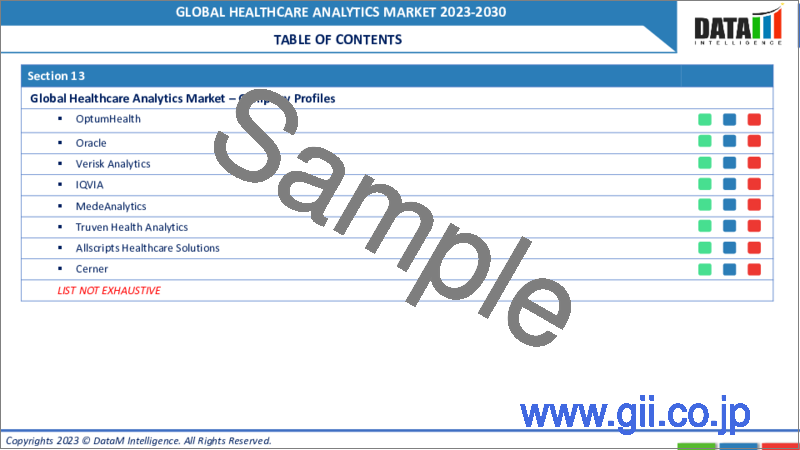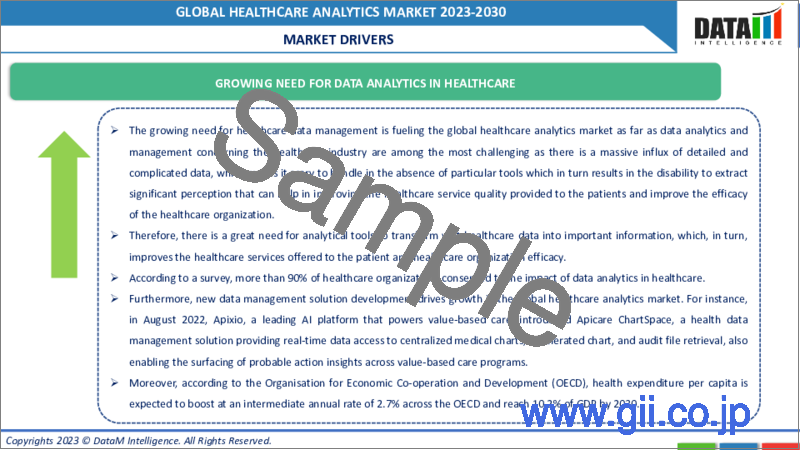|
|
市場調査レポート
商品コード
1153769
ヘルスケアアナリティクスの世界市場-2022-2029Global Healthcare Analytics Market - 2022-2029 |
||||||
|
● お客様のご希望に応じて、既存データの加工や未掲載情報(例:国別セグメント)の追加などの対応が可能です。 詳細はお問い合わせください。 |
|||||||
| ヘルスケアアナリティクスの世界市場-2022-2029 |
|
出版日: 2022年11月15日
発行: DataM Intelligence
ページ情報: 英文 200 Pages
納期: 約2営業日
|
- 全表示
- 概要
- 目次
市場の概要
ヘルスケアアナリティクスの市場規模は、予測期間(2022-2029年)にCAGR11.7%で成長すると推定されます。
ヘルスケアアナリティクスは、既存の業界データと文書化された業界データを精査し、動向の予測、アウトリーチの強化、さらには病気の蔓延を十分に管理するものです。ヘルスケアアナリティクスは、企業の幅広い領域を網羅し、マクロとミクロのレベルを理解することを提案します。患者ケアの質、臨床データ、診断、ビジネスマネジメントを向上させる方法を明らかにします。
市場力学
世界のヘルスケアアナリティクス市場の主な原動力は、ヘルスケアデータ分析のニーズの高まり、新製品の発売、慢性疾患の有病率の上昇、モバイルテクノロジーとインターネットの利用の増加、人口健康管理の需要の高まりです。
ヘルスケアにおけるデータ分析のニーズの高まりと新製品のイントロダクションが、世界のヘルスケアアナリティクス市場の成長を後押ししています。
ヘルスケアデータ管理のニーズの高まりが、世界のヘルスケアアナリティクス市場の成長を後押ししています。ヘルスケア業界に関するデータ分析・管理は、詳細かつ複雑なデータが大量に流入するため、特定のツールがないと扱いが難しく、その結果、患者に提供する医療サービスの質の向上や医療機関の効率化に役立つ重要な認識を引き出すことができなくなり、最も難しいもの1つです。そのため、膨大なヘルスケアデータを重要な情報に変換し、患者さんに提供するヘルスケアサービスの向上と医療機関の効率化につなげるための分析ツールが求められています。ある調査によると、90%以上の医療機関が、ヘルスケアにおけるデータ分析の影響に同意しています。
さらに、新しいデータ管理ソリューションの開拓が、世界のヘルスケアアナリティクス市場の成長を後押ししています。例えば、2022年8月、バリューベースケアを強化する大手AIプラットフォームであるアピクシオは、集中管理されたカルテへのリアルタイムデータアクセス、カルテと監査ファイルの検索を加速し、またバリューベースケアプログラム全体で確率的アクションインサイトの表面化を可能にする医療データ管理ソリューション「Apcare ChartSpace」を発表しました。
データセキュリティの懸念とコストは、世界のヘルスケアアナリティクス市場の成長の妨げになります。
しかし、分析ソリューションのデータセキュリティに関する懸念とコストは、世界のヘルスケアアナリティクス市場の成長を阻害することになります。例えば、ハッキングやセキュリティ違反が絶えない中、データセキュリティのリスクは高く、ヘルスケア企業にとってはコスト高となり、事前承認なしに患者データを開示することは非倫理的であることが判明します。さらに、データ分析ツールやサービスにはライセンスやサブスクリプションが必要であり、組織に経済的負担を強いることになります。
COVID-19の影響
ビッグデータツールはヘルスケアの意思決定においてますます重要性を増しているため、パンデミックは世界のヘルスケアアナリティクス市場にプラスの影響を及ぼしました。医療機関、WHOなどの規制機関、NIHが予測モデルを通じてパンデミックと戦い、リソースの配分、急増の予測、患者ケアと転帰の改善、予防措置の採用などに役立てられました。データの流入がほぼ一定数であったため、その健康データを分析することで、患者への対応や治療方法について、より合理的に理解することが可能になりました。このように、パンデミックは、ヘルスケアにおけるデータ分析の重要性を認識させ、ヘルスケアアナリティクスの利用を促進し、市場にプラスの影響を与えたのです。
目次
第1章 調査手法と調査範囲
- 調査手法
- 調査目的および調査範囲
第2章 市場の定義と概要
第3章 エグゼクティブサマリー
第4章 市場力学
- 市場影響要因
- 促進要因
- ヘルスケアにおけるデータ解析のニーズの高まり
- 市場戦略
- 抑制要因
- セキュリティに関する懸念
- 高いライセンシングコスト
- ビジネスチャンス
- 影響分析
- 促進要因
第5章 産業分析
- ポーターのファイブフォース分析
- サプライチェーン分析
- 規制分析
第6章 COVID-19の分析
- COVID-19の市場分析
- COVID-19以前の市場シナリオ
- COVID-19の現在の市場シナリオ
- COVID-19の後、または将来のシナリオ
- COVID-19の中での価格ダイナミクス
- 需要-供給スペクトラム
- パンデミック時の市場に関連する政府の取り組み
- メーカーの戦略的取り組み
- まとめ
第7章 コンポーネント別
- ソフトウェア
- ハードウェア
- サービス
第8章 アプリケーション別
- 臨床管理
- 財務管理
- オペレーション管理
- ポピュレーションヘルスマネジメント
第9章 製品別
- 記述的
- 予測型
- プリスクリプティブ
第10章 エンドユーザー別
- クリニック
- 病院
- その他
第11章 地域別
- 北米
- 米国
- カナダ
- メキシコ
- 欧州
- ドイツ
- 英国
- フランス
- イタリア
- スペイン
- その他欧州
- 南米
- ブラジル
- アルゼンチン
- その他の南米地域
- アジア太平洋地域
- 中国
- インド
- 日本
- オーストラリア
- その他アジア太平洋地域
- 中東・アフリカ地域
第12章 競合情勢
- 主な展開と戦略
- 企業シェア分析
- 製品ベンチマーク
第13章 企業プロファイル
- McKesson
- 企業概要
- 製品ポートフォリオと説明
- 主なハイライト
- 財務概要
- IBM
- OptumHealth
- Oracle
- Verisk Analytics
- Centene
- MedeAnalytics
- Enlitic
- Allscripts Healthcare Solutions
- Cerner
第14章 DataM
Market Overview
Healthcare Analytics Market size was valued at US$ YY million in 2021 and is estimated to reach US$ YY million by 2029, growing at a CAGR of 11.7% during the forecast period (2022-2029).
Healthcare analytics scrutinizes existing and documented industry data to forecast trends, enhance outreach, and even sufficiently manage the spread of diseases. Healthcare analytics encompasses a wide spectrum of enterprises, offering to understand the macro and micro levels. It reveals ways to improve patient care quality, clinical data, diagnosis, and business management.
Market Dynamics
The major driving forces for the global healthcare analytics market are the growing need for healthcare data analysis, new product launches, the rising prevalence of chronic diseases, the increasing use of mobile technology and the internet, and the increasing demand for population health management.
The growing need for data analytics in healthcare and new product introductions is boosting the global healthcare analytics market growth.
The growing need for healthcare data management is fueling the global healthcare analytics market as far as data analytics and management concerning the healthcare industry is among the most challenging as there is a massive influx of detailed and complicated data, which makes it scary to handle in the absence of particular tools which in turn results in the disability to extract significant perception that can help in improving the healthcare service quality provided to the patients and improve the efficacy of the healthcare organization. Therefore, there is a great need for analytical tools to transform vast healthcare data into important information, which, in turn, improves the healthcare services offered to the patient and healthcare organization efficacy. As per a survey, more than 90% of healthcare organizations consented to the impact of data analytics in healthcare.
Furthermore, new data management solution development drives growth in the global healthcare analytics market. For instance, in August 2022, Apixio, a leading AI platform that powers value-based care, introduced Apicare ChartSpace, a health data management solution providing real-time data access to centralized medical charts, accelerated chart and audit file retrieval, also enabling the surfacing of probable action insights across value-based care programs.
The data security concerns and costs will hamper the global healthcare analytics market growth.
However, the analytical solutions' data security concerns and costs will hamper the growth of the global healthcare analytics market. For instance, with constant hacking and security violations, there are high data security risks, which will prove costly to healthcare companies and unethical to disclose patient data without prior authorization. Furthermore, data analytic tools and services will require licensing or subscription, creating a financial burden on the organization.
COVID-19 Impact
The pandemic positively impacted the global healthcare analytics market since big data tools have become increasingly important in healthcare decision-making. It helped healthcare providers, regulatory bodies like WHO, and NIH fight against the pandemic via predictive models to help allocate resources, predict surges, improve patient care and outcomes and employ preventive measures. As data influx was at a near-constant rate, analyzing that health data has enabled a more reasonable understanding of ways to respond to and treat patients. Thus, the pandemic has made us realize the importance of data analytics in healthcare and promoted the use of healthcare analytics, positively impacting the market.
Segment Analysis
Software solutions for healthcare analytics are expected to grow at the fastest CAGR during the forecast period (2022-2029).
Healthcare analytics software is expected to grow at the fastest CAGR during the forecast period (2022-2029) as software solutions do not require new infrastructure than existing for installation and can be easily accessed from anywhere on the device compared to the healthcare hardware analytic solution, which requires infrastructure for installation and can not be accessed from anywhere else. The construction of new infrastructure increases financial spending. Furthermore, introducing software analytics with AI has ensured the dominance of software healthcare analytical solutions over the global healthcare analytics market. For instance, in January 2020, MORE Health, a global healthcare company, introduced a new Artificial Intelligence (AI) feature on MORE Health's Physician Collaboration Platform, benefiting both the physician and patient sides of the platform. Therefore, from the mentioned data, software solutions for healthcare analytics are predicted to dominate the global market during the forecast period.
Geographical Analysis
North America holds the largest share of the global healthcare analytics market.
The North American region retains a large share of global healthcare analytics and is estimated to continue to retain it in the forecast period (2022-2029). Most of the key market players are based in the United States and have a large stake in the global healthcare analytics market through different market tactics such as collaborations, product launches, acquisitions, partnerships and many others. For instance, in October 2022, Enlitic, a leading healthcare IT company, partnered with MULTI Inc., a healthcare technology provider of authentic parts, equipment, and services. The partnership is aimed to bring the Enlitic Curie platform to healthcare providers across the U.S., helping the radiology departments drive operational improvements. Also, in December 2020, Centene, a leading multi-national healthcare enterprise, acquired Apixio, a healthcare analytics company offering Artificial Intelligence (AI) technology solutions to make sense of unstructured clinical data for its millions of members. Apixio operates independently underneath Centene's Health Care Enterprises group. Therefore, as per the data above, it is estimated that North America will dominate the global healthcare analytics market throughout the forecast period.
Competitive Landscape
The key players operating in the global healthcare analytics market are IBM, OptumHealth, Oracle, Verisk Analytics, Centene, MedeAnalytics, McKesson, Enlitic, Allscripts Healthcare Solutions, and Cerner. The key players are adopting various strategies such as product launches, mergers & acquisitions, partnerships, and collaborations, contributing to the growth of the healthcare analytics market globally. For instance, in March 2021, McKesson Corporation introduced ScriptPAS, a pharmacy management platform for oncology practices.
McKesson Corporation
Overview:
McKesson Corporation is a Texas, United States-based company founded in 1833. American company business deals with distributing pharmaceuticals and providing health information technology, medical supplies, and care management tools. McKesson Corporation delivers the third of all pharmaceuticals used in North America.
Product Portfolio:
McKesson Corporation's product portfolio for healthcare analytics has McKesson Business AnalyticsSM: Which provides actionable insights and detailed reporting necessary to help manage the business through identifying savings opportunities, correcting inefficiencies, increasing ordering compliance and building resilience in the supply chain.
The global healthcare analytics market report would provide access to approximately 40+ market data tables, 45+ figures, and in the range of 200 (approximate) pages.
Table of Contents
1. Methodology and Scope
- 1.1. Research Methodology
- 1.2. Research Objective and Scope of the Report
2. Market Definition and Overview
3. Executive Summary
4. Market Dynamics
- 4.1. Market Impacting Factors
- 4.1.1. Drivers
- 4.1.1.1. Growing Need for Data Analytics in Healthcare
- 4.1.1.2. Market Strategies
- 4.1.2. Restraints
- 4.1.2.1. Security Concerns
- 4.1.2.2. High Licensing Cost
- 4.1.3. Opportunity
- 4.1.4. Impact Analysis
- 4.1.1. Drivers
5. Industry Analysis
- 5.1. Porter's Five Forces Analysis
- 5.2. Supply Chain Analysis
- 5.3. Regulatory Analysis
6. COVID-19 Analysis
- 6.1. Analysis of Covid-19 on the Market
- 6.1.1. Before COVID-19 Market Scenario
- 6.1.2. Present COVID-19 Market Scenario
- 6.1.3. After COVID-19 or Future Scenario
- 6.2. Pricing Dynamics Amid Covid-19
- 6.3. Demand-Supply Spectrum
- 6.4. Government Initiatives Related to the Market During the Pandemic
- 6.5. Manufacturer's Strategic Initiatives
- 6.6. Conclusion
7. By Components
- 7.1. Introduction
- 7.1.1. Market Size Analysis, and Y-o-Y Growth Analysis (%), By Components
- 7.1.2. Market Attractiveness Index, By Components
- 7.2. Software
- 7.2.1. Introduction
- 7.2.2. Market Size Analysis, US$ Million, 2021-2029 and Y-o-Y Growth Analysis (%), 2021-2029
- 7.3. Hardware
- 7.4. Services
8. By Application
- 8.1. Introduction
- 8.1.1. Market Size Analysis, and Y-o-Y Growth Analysis (%), By Application
- 8.1.2. Market Attractiveness Index, By Application
- 8.2. Clinical Management
- 8.2.1. Introduction
- 8.2.2. Market Size Analysis, US$ Million, 2021-2029 and Y-o-Y Growth Analysis (%), 2021-2029
- 8.3. Financial Management
- 8.4. Operations Management
- 8.5. Population Health Management
9. By Product
- 9.1. Introduction
- 9.1.1. Market Size Analysis, and Y-o-Y Growth Analysis (%), By Product
- 9.1.2. Market Attractiveness Index, By Product
- 9.2. Descriptive
- 9.2.1. Introduction
- 9.2.2. Market Size Analysis, US$ Million, 2021-2029 and Y-o-Y Growth Analysis (%), 2021-2029
- 9.3. Predictive
- 9.4. Prescriptive
10. By End-User
- 10.1. Introduction
- 10.1.1. Market Size Analysis, and Y-o-Y Growth Analysis (%), By End-User
- 10.1.2. Market Attractiveness Index, By End-User
- 10.2. Clinics
- 10.2.1. Introduction
- 10.2.2. Market Size Analysis, US$ Million, 2021-2029 and Y-o-Y Growth Analysis (%), 2021-2029
- 10.3. Hospital
- 10.4. Other
11. By Region
- 11.1. Introduction
- 11.1.1. Market Size Analysis, US$ Million, 2021-2029 and Y-o-Y Growth Analysis (%), 2021-2029, By Region
- 11.1.2. Market Attractiveness Index, By Region
- 11.2. North America
- 11.2.1. Introduction
- 11.2.2. Key Region-Specific Dynamics
- 11.2.3. Market Size Analysis, and Y-o-Y Growth Analysis (%), By Component
- 11.2.4. Market Size Analysis, and Y-o-Y Growth Analysis (%), By Application
- 11.2.5. Market Size Analysis, and Y-o-Y Growth Analysis (%), By Product
- 11.2.6. Market Size Analysis, and Y-o-Y Growth Analysis (%), By End User
- 11.2.7. Market Size Analysis, and Y-o-Y Growth Analysis (%), By Country
- 11.2.7.1. The U.S.
- 11.2.7.2. Canada
- 11.2.7.3. Mexico
- 11.3. Europe
- 11.3.1. Introduction
- 11.3.2. Key Region-Specific Dynamics
- 11.3.3. Market Size Analysis, and Y-o-Y Growth Analysis (%), By Component
- 11.3.4. Market Size Analysis, and Y-o-Y Growth Analysis (%), By Application
- 11.3.5. Market Size Analysis, and Y-o-Y Growth Analysis (%), By Product
- 11.3.6. Market Size Analysis, and Y-o-Y Growth Analysis (%), By End User
- 11.3.7. Market Size Analysis, and Y-o-Y Growth Analysis (%), By Country
- 11.3.7.1. Germany
- 11.3.7.2. The U.K.
- 11.3.7.3. France
- 11.3.7.4. Italy
- 11.3.7.5. Spain
- 11.3.7.6. Rest of Europe
- 11.4. South America
- 11.4.1. Introduction
- 11.4.2. Key Region-Specific Dynamics
- 11.4.3. Market Size Analysis, and Y-o-Y Growth Analysis (%), By Component
- 11.4.4. Market Size Analysis, and Y-o-Y Growth Analysis (%), By Application
- 11.4.5. Market Size Analysis, and Y-o-Y Growth Analysis (%), By Product
- 11.4.6. Market Size Analysis, and Y-o-Y Growth Analysis (%), By End User
- 11.4.7. Market Size Analysis, and Y-o-Y Growth Analysis (%), By Country
- 11.4.7.1. Brazil
- 11.4.7.2. Argentina
- 11.4.7.3. Rest of South America
- 11.5. Asia Pacific
- 11.5.1. Introduction
- 11.5.2. Key Region-Specific Dynamics
- 11.5.3. Market Size Analysis, and Y-o-Y Growth Analysis (%), By Component
- 11.5.4. Market Size Analysis, and Y-o-Y Growth Analysis (%), By Application
- 11.5.5. Market Size Analysis, and Y-o-Y Growth Analysis (%), By Product
- 11.5.6. Market Size Analysis, and Y-o-Y Growth Analysis (%), By End User
- 11.5.7. Market Size Analysis, and Y-o-Y Growth Analysis (%), By Country
- 11.5.7.1. China
- 11.5.7.2. India
- 11.5.7.3. Japan
- 11.5.7.4. Australia
- 11.5.7.5. Rest of Asia Pacific
- 11.6. Middle East and Africa
- 11.6.1. Introduction
- 11.6.2. Key Region-Specific Dynamics
- 11.6.3. Market Size Analysis, and Y-o-Y Growth Analysis (%), By Component
- 11.6.4. Market Size Analysis, and Y-o-Y Growth Analysis (%), By Application
- 11.6.5. Market Size Analysis, and Y-o-Y Growth Analysis (%), By Product
- 11.6.6. Market Size Analysis, and Y-o-Y Growth Analysis (%), By End User
12. Competitive Landscape
- 12.1. Key Developments and Strategies
- 12.2. Company Share Analysis
- 12.3. Product Benchmarking
13. Company Profiles
- 13.1. McKesson
- 13.1.1. Company Overview
- 13.1.2. Product Portfolio and Description
- 13.1.3. Key Highlights
- 13.1.4. Financial Overview
- 13.2. IBM
- 13.3. OptumHealth
- 13.4. Oracle
- 13.5. Verisk Analytics
- 13.6. Centene
- 13.7. MedeAnalytics
- 13.8. Enlitic
- 13.9. Allscripts Healthcare Solutions
- 13.10. Cerner
LIST NOT EXHAUSTIVE
14. DataM
- 14.1. Appendix
- 14.2. About Us and Services
- 14.3. Contact Us




